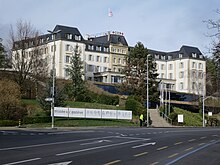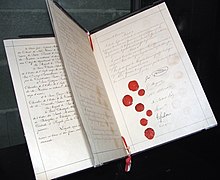International Red Cross and Red Crescent Museum
The International Red Cross and Red Crescent Museum (French: Musée international de la Croix-Rouge et du Croissant-Rouge , MICR) in Geneva documents the history and activities of the International Red Cross and Red Crescent Movement .
Opened in 1988, the museum is right next to the headquarters of the International Committee of the Red Cross (ICRC) and is visited by an average of 70,000 to 80,000 people annually. In addition to the permanent exhibition , changing special exhibitions are also shown in the museum . In addition, the museum has a number of collections and holds deposits from the International Committee of the Red Cross and the International Federation of Red Cross and Red Crescent Societies.
Organizational information
History and architecture
The museum goes back to the initiative of the former ICRC delegate Laurent Marti , who promoted this idea from 1975. He is officially the founder of the museum. On November 20, 1985, on the occasion of the summit meeting of their husbands in Geneva , the wives of the then heads of state of the United States and the Soviet Union , Nancy Reagan and Raisa Gorbatschowa , together with Ursula Furgler, the wife of Swiss President Kurt Furgler , laid the foundation stone Construction. Almost three years later, on October 29, 1988, the museum was inaugurated by the then Swiss Federal President Otto Stich . Some of the exhibits for the initial installation came from the exhibition of the Henry Dunant Institute, which has been in existence since 1974 . The construction and installation, which cost around 24 million Swiss francs , were financed by donations from around 300 private individuals, companies and public institutions. On July 18, 2003, the millionth visitor was received. From the opening (1988) to the renovation (2011–2013), 1,796,249 people from 174 countries, 51% of them under 25, visited the museum. In the last five years before the renovation, an average of around 100,000 people visited the museum each year.
The museum was designed by the architects Pierre Zoelly (Zurich), Georges Haefeli (La Chaux-de-Fonds) and Michel Girardet (Geneva) following a corresponding competition . It is built in Geneva on avenue de la Paix halfway up the hill on which the headquarters of the International Committee of the Red Cross is located. It is thus directly opposite the Palais des Nations , formerly the seat of the League of Nations and now the European headquarters of the United Nations . The way to the entrance leads through a ditch and then into an inner courtyard. This is spanned by the symbols of the movement, the Red Cross and the Red Crescent, on two large sails. This construction is intended to symbolize the work of the delegates in the field, under the protection of the two symbols and often hidden from the public.
In front of the entrance is the sculpture “The Petrified”, created by Carl Bucher in 1979 , which depicts the suffering of the victims of human rights violations and violence in the form of life-size, bound figures . In the interior design of the museum, technical installations such as water and power lines were deliberately built so that they are clearly visible in the building, which is intended to symbolize the provisional character of the practical Red Cross work.
The total area of the museum comprises 3640 square meters on three levels, of which 2065 square meters are exhibition space. The museum also has a restaurant, an auditorium with a multimedia area and a museum shop.
Between June 2011 and May 2013 the museum was closed due to extensive renovation work.
Administration and Financing
The sponsor is the Fondation du Musée international de la Croix-Rouge et du Croissant-Rouge .
The director of the museum has been the art historian Roger Mayou since June 1998, who previously worked as deputy curator at the Museum of Art and History in Freiburg and as a consultant for the art collection of the financial services provider UBS. As curator , Loa Haagen Pictet is responsible for supervising the exhibition; the visual concept was designed by Roger Pfund and Nicolas Bouvier. The museum has 16 employees and around 50 volunteers.
In addition to income from admission fees, donations, financial support from the Friends of the Museum (AMICR) and sales in the museum shop, the Swiss Federal Government (approx. 965,000 Swiss francs per year), the canton of Geneva (approx. 560,000 Swiss francs per year) and the ICRC (approx. 200,000 Swiss francs per year) contributes to the financing of the running costs. From a legal point of view, the museum is a private foundation under federal supervision.
Content design
Previous permanent exhibition
The museum's previous permanent exhibition was devoted to various aspects of the history and activities of the International Red Cross and Red Crescent Movement in eleven rooms. Room 1 “Preserving life through writings” documented the power and meaning of the written word in the effort to protect human life. The central exhibit in this room were six veils, optically superimposed by the lighting, on which statements regarding respect for life were given in different languages and scripts. In room 2, "Preserving life through personal commitment" , examples of personal commitment to the benefit of war victims were shown on the basis of the founder of the Red Cross movement, Henry Dunant , the English nurse Florence Nightingale , the Russian surgeon Nikolai Pirogow and the American volunteer Clara Barton . Room 3, “The Battle of Solferino (June 24th, 1859)” was dedicated to the event that Henry Dunant described in his book “A Memory of Solferino” and that gave rise to the founding of the International Committee of the Red Cross. The history and importance of this battle was illustrated by a slide panorama from contemporary representations. The theme of room 4 was "The founding of the Red Cross (1862-1863)" . A sculpture by the American sculptor George Segal entitled "Henry Dunant at his desk" was shown here. Room 5 “On the way to universality (1864-1914)” showed the way of the Red Cross to a worldwide movement with the help of time tables and various exhibits.
The First World War , the space 6 were "Prisoners of war (1914-1918)" and the space 7 "The First World War (1914-1918)" dedicated. The central exhibit, on permanent loan, was the complete prisoner of war index of the International Central Agency for Prisoners of War of the International Committee of the Red Cross from the First World War , consisting of around seven million cards . Room 8 “The Interwar Period (1919-1939)” showed the challenges facing the ICRC through internal conflicts, the emergence of the League of Red Cross Societies and the inclusion of the Red Crescent as a new symbol in the Geneva Conventions . Room 9 “The Second World War (1939-1945)” documented the work of the ICRC and the League during the Second World War . In room 10, “From 1945 to the 1980s” , the work of the Red Cross and Red Crescent organizations was shown on site using posters from all over the world. Room 11 “Today” , redesigned in 1999, illustrated current activities of the movement in five exhibition units. In the area of "Overcoming" , examples of relief operations in the event of natural disasters were documented, the area "Improving" was dedicated to selected social programs of some national societies. In the “Rehabilitation” exhibition unit , the movement's aid measures for mine victims were presented, and in the “Protect” section, the work for prisoners. Here, for example, a cell replicated in its original dimensions could be viewed, which a delegate visited during a prisoner visit. The “Connect” section showed the work of the Red Cross in searching for missing persons and reuniting families. The central exhibit was a collection of Polaroid photos of children in Rwanda, which the ICRC took after the genocide in 1994 to search for the parents of these children.
New permanent exhibition: The Humanitarian Adventure
The exhibition of the museum was fundamentally redesigned as part of extensive renovations from June 2011 to 2013, whereby the traditional museum concept was removed. The permanent exhibition “The Humanitarian Adventure” is intended to convey emotions, discoveries and food for thought, as well as providing an insight into humanitarian work.
In three exhibition units, the challenges of our time are thematized by well-known architects from different cultures: “Defending human dignity” (Gringo Cardia, Brazil), “ Restoring family ties” ( Diébédo Francis Kéré , Burkina Faso), “Limiting the risks of natural hazards” ( Shigeru Ban , Japan).
A joint visitor center for the museum and the ICRC has been created for this purpose.
Special exhibitions
Within the exhibition area, 215 square meters are used for changing special exhibitions. These are mainly dedicated to topics that are not or only partially presented in the permanent exhibition, in particular individual historical aspects and current events or actions from the present. The special exhibitions in recent years have included:
- "The child in war"
- "From rifle to stretcher"
- "Help, profession: helper"
- "WAR - USA - Afghanistan - Iraq"
- "Cambodia 1975–1979. Chronicle of a Genocide "
- "In The Field. From Solferino to Guantanamo "
Collections
The museum has a number of collections that document the history of the International Red Cross and Red Crescent Movement, including deposits from the International Committee of the Red Cross and the International Federation of Red Cross and Red Crescent Societies. These collections include around 15,000 photographs from all times and areas of application in the history of the Red Cross, around 950 film titles and around 3,000 posters. The museum also has collections of Red Cross postage stamps, medals, and badges, as well as around 500 items made by prisoners and given as gifts to ICRC delegates. Some of these works are shown in the permanent exhibition.
literature
- Roger Mayou (Ed.), Cornelia Kerkhoff (German transl.): Internationales Rotkreuz- und Rothalbmondmuseum. Self-published by the museum, Geneva 2000, ISBN 2-88-336009-X
Web links
Individual evidence
- ↑ Press kit The Humanitarian Adventure. Musée international de la Croix-Rouge et du Croissant-Rouge, accessed November 24, 2016 .
Coordinates: 46 ° 13 '38.1 " N , 6 ° 8' 12.7" E ; CH1903: four hundred and ninety-nine thousand five hundred and seventy / 120370





